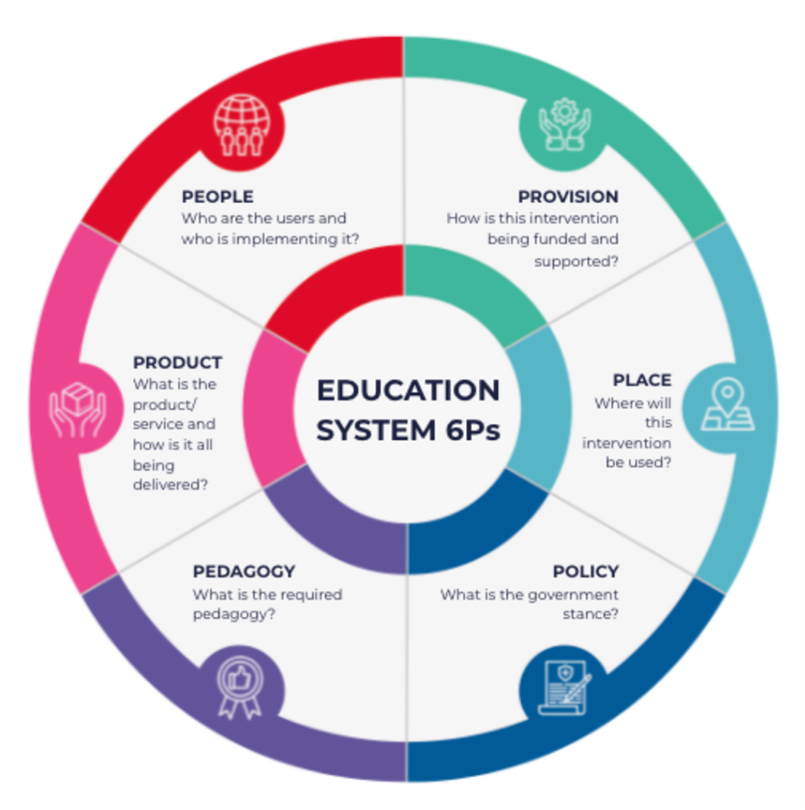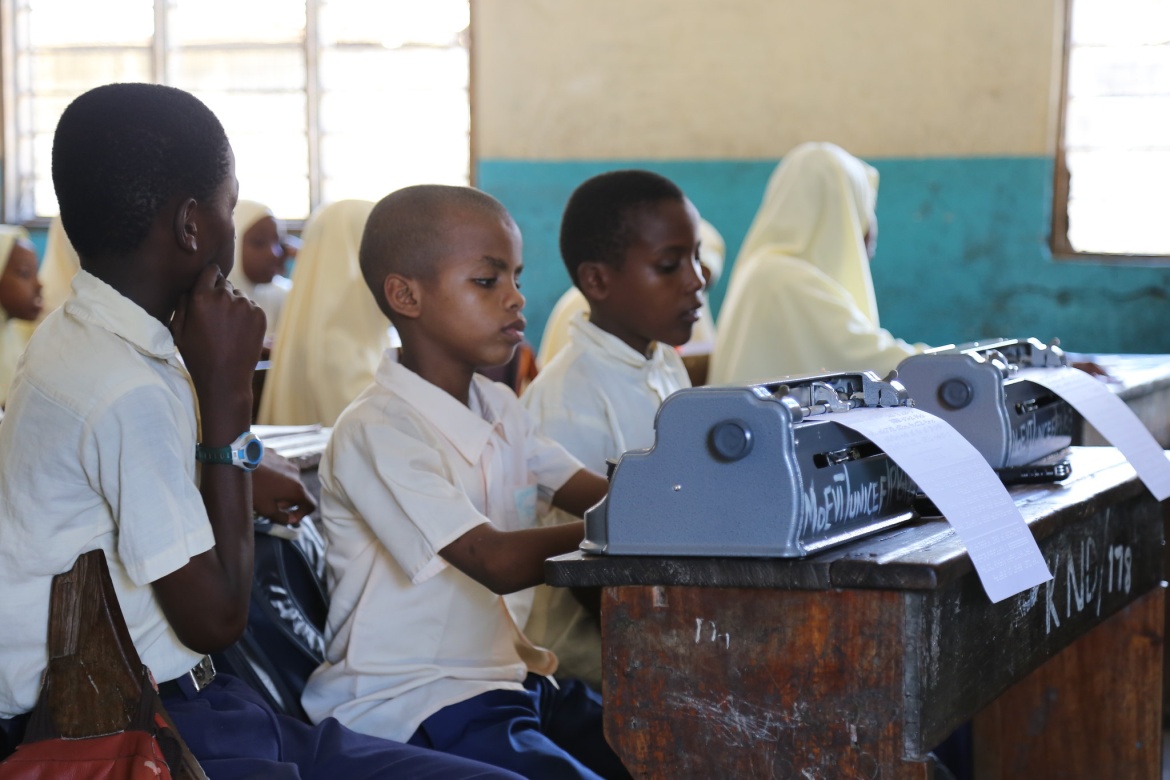Resource Type
Blog
While technology has the potential to bridge disparities for students with disabilities, accessibility and utility challenges can exacerbate inequalities. Here are some tools and resources to help development actors in designing, implementing and monitoring disability-inclusive technology solutions.
This blog was originally posted on globalpartnership.org on November 20, 2023 by Charlotte McClain-Nhlapo, The World Bank, Ruchi Kulbir Singh, The World Bank, and Sophia D’Angelo, The World Bank
PHOTO: In the front row, two blind students use Braille machines during class. Kisiwandui primary school in Zanzibar, Tanzania.
Credit: GPE/Chantal Rigaud
In the dynamic world of education, technology acts as a potent catalyst, bridging gaps and creating opportunities. However, for the 240 million children and youth with disabilities, technology, though promising, can also pose a threat to their inclusion.
As we learned from the COVID-19 pandemic, the transformative power of information and communication technology (ICT) emerges as a double-edged sword. While it has the potential to bridge educational disparities for students with disabilities, accessibility and utility challenges can exacerbate existing inequalities.
A global survey conducted by the World Bank’s Inclusive Education Initiative (IEI) with 4,000 stakeholders, during school closures caused by the pandemic, found that approximately 1 in 4 parents of children with disabilities lacked access to the internet (25%) or digital devices (23%).
Almost half (46%) of parents and teachers of children with disabilities surveyed were concerned with whether children with disabilities would know how to use technology appropriately to continue their learning.
Parents' perceptions of the accessibility and usefulness of each digital asset were largely shaped by their child’s physical, cognitive or psychosocial needs.

Highlighting this, one parent from the LAC (Latin America and the Caribbean) region wrote, “It is necessary to know the specifics of each student and provide different resources.”
Indeed, this year’s Global Education Monitoring Report on Educational Technology, published by UNESCO, calls for decisions about technology in education to prioritize learner needs. Now more than ever, we must harness the potential of ICT to ensure that no learner is left behind.
Using ICT to develop an inclusive learning environment
While there is no silver bullet to designing inclusive digital solutions, the journey to inclusive education through ICT encompasses a spectrum of possibilities ranging from simplistic tools to innovative technological advancements. Potential solutions to facilitate inclusion in remote and in-person educational environments are abundant.
When selecting the appropriate technology for learners with disabilities, various considerations should be made, from access and age-appropriateness, students’ level of digital skills, physical and cognitive needs, and relevance of the learning content or curriculum.
Identifying learner needs and the contextual factors shaping EdTech and digital inclusion is of paramount importance.
Low-tech devices such as screen readers and adaptive keyboards as well as high-tech solutions like specialized software and innovative applications have paved the way for a more inclusive learning environment. The integration of artificial intelligence (AI) has also opened new doors to personalized learning experiences, tailored to individual needs and preferences.
The World Bank and the Inclusive Education Initiative (IEI) have been at the forefront in driving transformative research and operations to support digital inclusion in low- and middle-income countries.
In Ethiopia, for example, the General Education Quality Improvement Program for Equity (GEQIP-E) supports the screening and identification of children with disabilities as well as the roll-out of assistive technologies, tools and approaches appropriate for the purpose, context and target group in the country’s Inclusive Education Resource Centers.
Tools for contextualizing digital technology in inclusive education
Recognizing the pivotal role of technology in promoting inclusive education, IEI recently published the 'Landscape Review of ICT for Disability-Inclusive Education' to serve as a guiding compass, identifying key challenges and opportunities in leveraging technology for inclusive learning. In it, the 6Ps framework summarizes the 6 essential components of the entire ecosystem: people, products, pedagogy, policy, place and provision.

Credit:Plaut et al., 2020, cited in World Bank, 2022
The framework seeks to help policy makers, practitioners and researchers identify what is and is not working, stressing the interdependence between each of the 6 components.
Given the limited evidence on the costs of digital solutions, the World Bank Education Global Practice – with the support of IEI – has also introduced the Tech-Enabled Disability Inclusive Education (TEDDIE) Costing Tool that draws on the 6Ps framework to support education policy makers and decision-makers in planning, costing and budgeting for inclusive digital solutions that support students with disabilities.
The TEDDIE tool can be used in collecting and analyzing data, including market analysis that draws on local costs – not just for initial purchase, but also for maintaining and repairing technology – as well as any additional training needed for teachers and other stakeholders to effectively use digital tools in schools.
By providing a comprehensive understanding of the costs involved in implementing ICT solutions for learners with disabilities, the TEDDIE tool facilitates informed decision-making and resource allocation, ensuring the effective implementation and sustainability of inclusive and tech-enabled education programs.
Looking forward…
As we stride toward a more equitable and inclusive educational landscape, the transformative power of ICT stands as a beacon of hope. Here we’ve presented just a few of the recent tools and resources that will help development actors in designing, implementing and monitoring disability-inclusive ICT solutions.
By fostering innovative solutions and leveraging the collaborative efforts of global stakeholders, we can pave the way for a future where every learner, regardless of ability, has equal access to quality education.
Additional resources
- Disability Inclusion at the World Bank
- Pivoting to Inclusion: Leveraging Lessons from the COVID-19 Crisis for Learners with Disabilities
- Technical Note on Accessibility Fact Sheet 2: Accessibility in the ICT Sector of Operations
- Increasing Access to Technology for Inclusion
- EdTech Readiness Indicator (ETRI)

